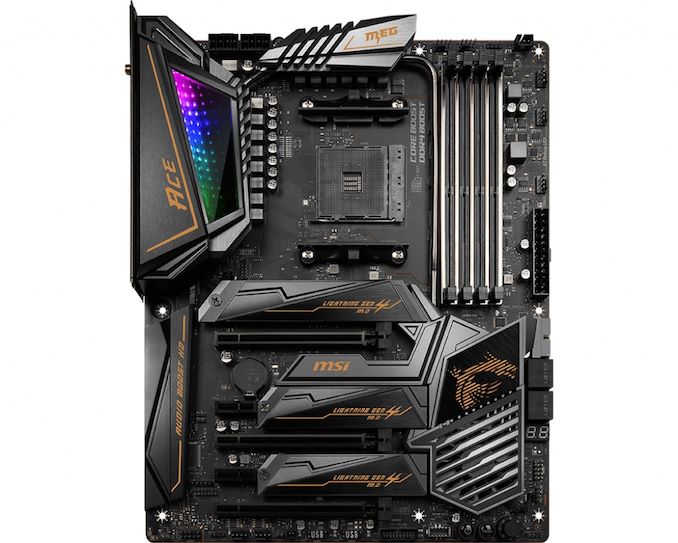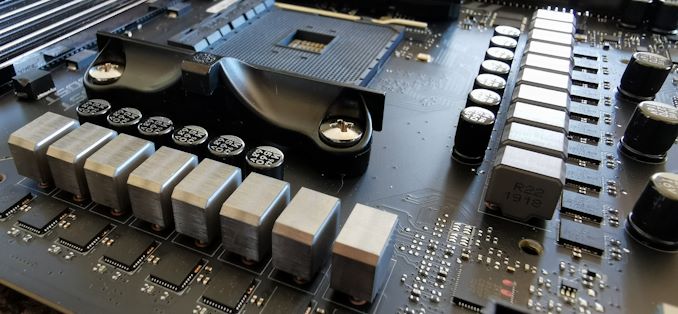The MSI MEG X570 Ace Motherboard Review: Ace in the Hole at $369
by Gavin Bonshor on July 18, 2019 11:00 AM EST- Posted in
- Motherboards
- AMD
- MSI
- AM4
- Zen 2
- Ryzen 3000
- X570
- MEG
- X570 Ace
- 3700X
- Ryzen 3700X
MSI MEG X570 Ace Conclusion
The MSI MEG X570 Ace is an ATX motherboard which sits very much in the mid-range of the currently X570 product stack with an MSRP of $369. This has raised a lot of questions over social media as to why X570 comes with a higher price tag over previous the previous generations of X470 and X370 models. This is simple, the X570 models are better quality and the mid-range models such as this one come with a much better feature set as standard, as well as better quality componentry within. Another aspect is the addition of PCIe 4.0 and more native support for things like M.2 slots from the CPU and chipset, USB 3.1 G2 connectivity and on some models, the inclusion of additional high performance controllers.
In terms of its overall design, the X570 Ace is very similar to its Intel desktop variation, the MSI MEG Z390 Ace which we reviewed last year. The biggest difference visually is the fan intake grill on the X570 chipset heatsink which is a direct consequence of the chipset 11 W TDP; MSI has included a cooling fan to keep things running cool, which actually serves two purposes on this model. The power delivery heatsink and chipset heatsink are interconnected with a heatpipe, and in our thermal analysis the MSI MEG X570 has very cool running VRMs with our Ryzen 7 3700X at our maximum achieved overclock. On the rear panel cover is the MSI RGB Infinity Mirror which adds a bit of flair, but the most notable design comes in the gold accents which seems to be a direct shout out to AMD's 50 year anniversary, although not officially stated. Although the integrated RGB LEDs are primarily through the Infinity Mirror, MSI does include vast amounts of RGB LED connections for users to create a unique rainbow-like disco in their chassis. One thing we noted in our preview before launch, there is quite a noticeable amount of plastic around the board, especially the rear panel area and the chipset heatsink. This detracts slightly from the premium element, but it fits in well with the boards aesthetic; it doesn't detriment performance and is purely for visual effect.
For the feature set on offer which includes a long list including dual Ethernet ports on the rear panel, one 2.5 GbE and the other 1 GbE, a Realtek ALC1220 HD audio codec, and an Intel AX200 Wi-Fi 6 802.11ax wireless interface which also offers BT 5 connectivity. While the X570 Ace only includes four SATA ports, MSI has used the modular nature of the PCIe 4.0 lanes on the X570 chipset to provide a total of three PCIe 4.0 x4 M.2 slots. Each of these M.2 slots has its own heatsink which blends in with the aesthetic of the board. The top two full-length PCIe 4.0 slots are driven by the CPU which operate at x16 and x8/x8, whereas the bottom full-length slot comes via the X570 chipset and is locked down to x4.
Its overall performance is underpinned by the Ryzen 7 3700X we use on the test bench. In the majority of our test suite, the MSI MEG X570 Ace performs better than the B450/X470 models we have tested so far. Power consumption at full load was noticeably higher but can be attributed to a number of factors including CPU Vcore at default settings, as well as the X570 chipset which has a TDP of 11 W. In our new thermal VRM analysis testing, the MSI MEG X570 Ace performed very well and shows that the 12+2 power delivery running in a 6+2 configuration spearheaded by an International Rectifier IR35201 PWM controller. Putting it quite simply, the power delivery and heatsinks on the X570 Ace are very capable and stands it as one of the better designs seen from MSI over the years.
Looking at the overclocking performance, we managed to get 4.3 GHz out of our Ryzen 7 3700X albeit without the heavier AVX2 workloads, but with a CPU VCore of 1.375 V. MSI's pre-defined overclocking Game Boost profiles aren't great with way too many volts applied which resulted in CPU temperatures skyrocketing into triple-digit numbers. This is something MSI needs to go back to the drawing board on as 4.2 GHz does not require 1.558 of CPU VCore at full load; this resulted in a maximum temperature of 103 degrees Celcius even with a good quality 240 mm AIO CPU cooler installed. For users that intend to overclock their Ryzen 3000 processors, MSI has included a total of seven 4-pin fan headers which is quite impressive for a mid-range model.
At its current price point, the MSI MEG X570 Ace ($369) is in direct competition with a handful of models including the GIGABYTE X570 Aorus Master ($360), the ASUS ROG X570 Crosshair VIII Hero WIFI ($380), and the ASRock X570 Phantom Gaming X ($350), with the latter on paper comes with a very similar feature set but at a slightly lower price. The MEG X570 Ace has initial niggles including the laggy launch firmware and irrational overclocking presets, but marks a big step forward for MSI in terms of power delivery, and its networking capabilities. The MSI MEG X570 represents a good example of an enthusiast-level gaming themed board which steps things into another gear, which could, in turn, prove to be the ace in the hole of its current X570 product stack.
At the time of writing at Newegg, the current price for the MSI X570 Ace sits at $415. This is also reflected at Amazon US with a current selling price of $400. This is considerably more than the MSRP suggests and could be due to an issue with availability and stock levels as at both stores, the MSI X570 Ace is only available via third-party sellers. When Newegg and Amazon eventually receive stock, the price should drop down, but it would be recommended to check your local hardware stockist for pricing and availability. For the European markets, the MSI MEG X570 Ace is also available at Amazon UK with a price tag of £360, and at Amazon DE for 400€.
AnandTech Ryzen 3000 CPU and X570 Motherboard Coverage
- The AMD X570 Motherboard Overview: Over 35+ Motherboards Analyzed
- The AMD 3rd Gen Ryzen Deep Dive Review: 3700X and 3900X Raising The Bar
- AMD 16-Core Ryzen 9 3950X: Up to 4.7 GHz, 105W, Coming September
- AMD Zen 2 Microarchitecture Analysis: Ryzen 3000 and EPYC Rome
- AMD Ryzen 3000 Post-Review BIOS Update Recap: Larger ST Gains, Some Gains, Some Losses












92 Comments
View All Comments
Sparkyman215 - Thursday, July 18, 2019 - link
Why are certain seemingly random portions of the article specifically tagged a certain color? The body <p> tags are #444 but some snippets are set to rgb(68,68,68) (which is #444) in the same <p> tag. I know it literally doesn't matter to anyone but I noticed it and it's weird hahayeeeeman - Thursday, July 18, 2019 - link
Dear Anandtech, not everyone needs PCIe 4.0 and these gimmicky motherboards. Also, not everyone has over 200$ to throw, so please test all new Ryzens on B350 motherboards.Showtime - Thursday, July 18, 2019 - link
Yeah pricing is high IMO. I want to go AMD, but I can't justify spending $200 on motherboard for a $200 CPU. Some people have had to do some work to get the older, cheaper motherboards to work right after the bios update. Guess I'll wait and see. Not like my old Intel is slow.Holliday75 - Thursday, July 18, 2019 - link
I am of the opinion that unless you plan on buying a new PC in the next several years after putting a 3000 based system together then spend the money and get the x570 based board. There are cheaper models to choose from, but the PCI 4.0 support will be very nice to have down the road when GPU's are taking advantage of it. Having to upgrade a motherboard mid-ownership cycle would suck and eat up any savings you and then some by using a lower end board.If you already have one it looks like it works on most boards and the performance drop off is not that bad. In IT you pay now or pay later, but you always pay. I prefer up front to avoid it down the road when it tends to be more of a pain in the arse.
Irata - Friday, July 19, 2019 - link
Definitely agree with your comment.My plan is to get a good X570 mainboard now and use it with a Ryzen 3700x. Once the Ryzen 3000 series is EOL, I want to upgrade to a 3950x which hopefully can be had cheaper then.
Looking at the reviews of PCIe 4 NVMe that are available right now, I see little point in getting one now, but will definitely upgrade to one once Samsung and others offer them.
All of this I would like without having to replace the motherboard.
shabby - Thursday, July 18, 2019 - link
The 3900x works even on a320 boards but only hits around 3.7ghz tops. I honestly don't think these $300+ boards with trick vrm/phases are needed at all, these ryzen chips peak at 4.3ghz with liquid cooling. Even $200 boards should easily 16 cores at that speed.Targon - Thursday, July 18, 2019 - link
The cost of PCI Express 4.0 is the reason for the high motherboard prices. You do get what you pay for when it comes to motherboards.29a - Thursday, July 18, 2019 - link
I almost always buy a super cheap Asrock or Biostar motherboard and never have any issues with speed or stability.pavag - Saturday, July 20, 2019 - link
Maybe those motherboards are prepared for future processors, which need more power.29a - Thursday, July 18, 2019 - link
I agree I came here just to request reviews of cheap motherboards. Also an article addressing all the BIOS settings and detailed explanations on what they do on modern motherboards would be awesome too.